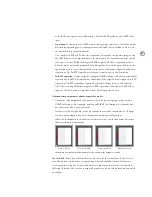
88
Except for the ink name, each property displayed in the ink list can be changed in the
options section below the ink list. Each ink in the list displays the following properties:
•
Ink status icon.
Indicates whether the ink is set to be separated as a spot ( ) or process
( ) color. Also indicates whether the ink is aliased to another ink ( ).
•
Ink name.
Displays the ink name supplied by the Swatches palette.
•
Type
. Indicates the trapping characteristics of the ink. The ink types are defined in the
Ink Options section below.
•
Density.
Indicates the neutral density of the ink. This option is described in more detail
in the Ink Options section below.
•
Sequence
. Indicates the ink’s position in the trapping order for inks. This option is
described in more detail in the Ink Options section below.
Ink options:
This section displays the options for the currently selected ink in the list.
•
Type
. Indicates the trapping characteristics of the ink. An ink can be one of four ink
types:
Normal
for traditional process inks and most spot inks.
Transparent
for clear inks to ensure that underlying items trap. Use this option for
varnishes and die lines.
Opaque
for heavy, non-transparent inks to prevent trapping of underlying colors but
allow trapping along the ink’s edges. Use this option for metallic inks.
OpaqueIgnore
for heavy non-transparent inks to prevent trapping of underlying colors
and to prevent trapping along the ink’s edges. Use this option for inks that have undesir-
able interactions with other inks.
•
Neutral Density.
Indicates the neutral density of the ink. If trapping is on, this value is
used by the selected trapping engine to calculate trapping requirements. You can adjust
the ink neutral density (ND) values that the selected trapping engine uses to determine
the precise placement of traps. The default ND values for process inks are based on the
neutral density readings of process ink swatches that conform to industry standards
in different parts of the world. For example, the ND values for the U.S. English and
Canadian versions of InDesign conform to the Specifications for Web Offset Publications
(SWOP) solid ink density values published by the Graphic Arts Technical Foundation of
North America. The Density option in the lower half of the dialog box lets you adjust a
process ink’s neutral density to match printing industry standards in a different part of
the world. See “Adjusting Neutral Density” below.
•
Sequence
. Indicates the ink’s position in the trapping order for inks. In most cases these
settings should only be changed after consulting the press operators.
















































